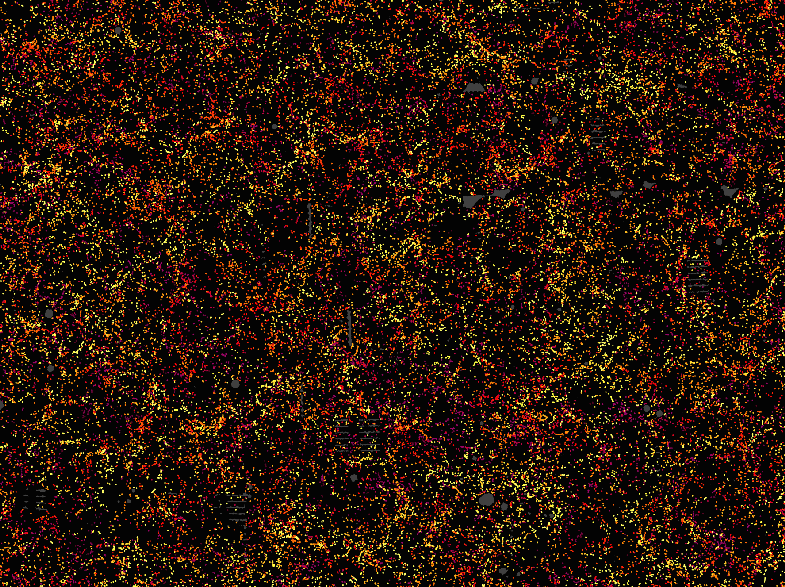Largest Map Ever Made Will Unlock The History Of The Universe
1.2 million galaxies

What you’re looking at is a slice of the entire universe, a web of galaxies billions of light years away. You’re also looking into the past, since the further into the distance you look, the longer it took that light to reach your eyes. It all seems a lot smaller until you realize that each of those dots is hundreds of thousands of light years across.
A collaboration of hundreds of scientists released the “largest-ever, three-dimensional map of distant galaxies” with over 1.2 million spots as a part of the Baryon Oscillation Spectroscopic Survey (BOSS) program using a telescope in New Mexico, according to a press release from Brookhaven National Lab. The map isn’t for wanderers; scientists are trying to understand some of the universe’s unexplained properties, like what dark matter and dark energy are. Understanding those things requires a three-dimensional map bigger and looking further out than any map scientists have made prior.
“The problem was, if you take data on the brightest galaxies in the sky, they happen to be nearby galaxies,” BOSS’ principal investigator David Schlegel from Lawrence Berkeley National Lab told Popular Science. “For a cosmologist, that’s just a map of the backyard. I don’t want a map of the backyard. I want a map of the universe.”
Up until fifty or so years ago, scientists more or less understood the universe, said Schlegel. But the discovery of dark matter and dark energy showed we don’t really understand most of it, since they make up around 95 percent of the stuff in the universe. Yeah, we don’t understand 95 percent of the stuff in the universe.
That’s not to say we can’t measure or detect dark matter and dark energy, though. If you look at the map, you’ll see a web of galaxies and places where dots clump. Dark matter still feels gravity’s pull, so galaxies align themselves along the webs and clumps of dark matter. We can detect dark energy too. When we look into space, really distant things we’d expect to look white actually look red; they’ve been redshifted. That’s because their light rays have stretched out, because the space itself the light travels through expands, like a stretched-out tattoo on someone who’s gaining a lot of weight.
By measuring really far away things, we found out that the universe wasn’t just expanding, but the rate it expanded was actually speeding up. That discovery won a team of scientists the 2011 Nobel Prize in Physics.
In one theory of the universe, there’s a single number called the “cosmological constant” that says dark energy is a uniform thing permeating the universe and making it expand. Some physicists were hoping that a larger map would show the cosmological constant’s value changing in different places, rather than just being a single number everywhere, but the single number stuck throughout the swath of the universe covered by BOSS’ results. Schlegel thought theoretical physicists might be a little pigeonholed by the results, since they can do more with varying numbers than a single constant.
Mark Wise, theoretical physicist at California Institute of Technology, hadn’t reviewed the BOSS results yet but agreed with Schlegel. “It would be more exciting if it was something else,” he told Popular Science.
The BOSS experiment is about more than just dark energy, though, pointed out Anže Slosar, Brookhaven National Lab and BOSS cosmologist who leads his “futile existence as a scientist and a bureaucrat” (much as a cosmologist would), according to his website. The experiment will also help pinpoint the mass of the neutrino particle. Soon, other experiments like the larger Dark Energy Spectroscopic Instrument (DESI) on a telescope at Kitt Peak in Arizona will pick up where the BOSS experiment leaves off. But Slosar was most excited about how intertwined our physical experiences on Earth are with the rest of the universe.
“The fact that it’s the same fundamental laws that guide GPS satellites all the way down to one second after the big bang is pretty mindblowing,” he said.